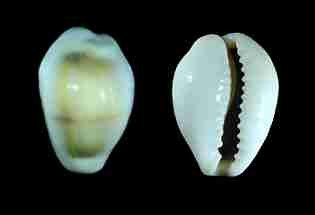Money cowries are such an important study for Anthropologists. At one time they were part of the global economy as a mutually agreed upon currency. They traveled the extensive trade networks that spread literally across the globe. I recently went to a museum in my town and saw a beautiful Native dress from BC decorated with cowries.
To read about the extensive trade of the cowrie (aka cowry), read this article available online. It includes a distribution map of the Cypraea moneta or Money Cowrie.
Another article discusses the early uses of cowrie as money. He places its origins in the Shang and Chou Dynasties so about 1766 BC. From that early use, the cowrie has been a trade currency up until this century in certain African centres.
But how did it get to the Canada?
A general search of information indicates that the cowrie was introduced by the English as a trade good to the Ojibwa people. Rapp and Hill mention in their book, Geoarchaeology: the earth-science approach to archaeological interpretation, that "Cowries were also used for human decoration in prehistoric Europe and North America." (p.211). It has also been noted in Jackson's book, Shells as Evidence of the Migrations of Early Culture;
“Some interesting evidence of the early use of the money cowry in North America is contained in an exhaustive account on Aboriginal sites on Tennesse River by C.B. Moore. In his description of the Roden mounds, Marshall County, Alabama, the author informs us that in burial no. 44, well in the body mound A, were fragments of a large marine bivalve, and five shells, some much decayed, which had been pierced for stringing, like beads. These were pronounced by Dr. H.A. Pilsbury, the well known American conchologist to be examples of the money currency, Cypreae moneta, of Eastern seas. Such shells have never been recorded before from an aboriginal mound in the United States. The careful investigation fo the Roden mounds indicated that they had been built before their makers had any intercourse with white persons. The presence of coweries therefore, is of special interest.”
There has to be more evidence out there, but its fascinating that such a little shell could make such an journey around the globe.
References:
Jackson, Wilfrid. 1917. Shells as Evidence of the Migrations of Early Culture. Manchester: University of Manchester. pp.186 & 188.
Rapp, George Robert and Hill, Christopher L. 2006. Geoarchaeology: the earth-science approach to archaeological interpretation. New Haven, Connecticut: Yale University Press.

Money Cowrie Seashells (Cypraea moneta) are so named because they used to carry the value of money and were used just as we use money today. This particular seashell is found around coral reefs of the Indo-Pacific. Each shell is approximately 1/2".
ReplyDelete____________________
Tools & Gifts For Your Spiritual Practice